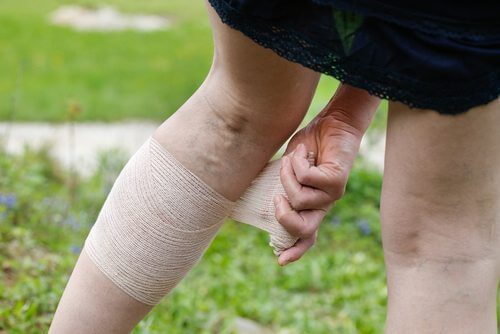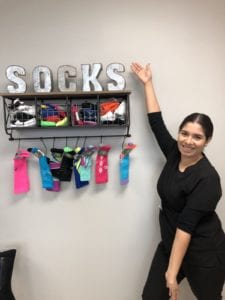
Lower leg ulcers are open sores that don't heal or keep coming back. In fact, they're one of the most common forms of chronic wounds in this country. Ulcers can develop on your lower legs. They usually show up around the ankles. But they also develop if you put consistent pressure on your foot. We can easily treat small ulcers. And stop them from returning. But if an ulcer is left untreated, it can grow deeper into your skin tissue. Or it may become infected. In that case, treatment will likely be drastic--and expensive.
How does a lower leg ulcer develop? Are there different kinds of ulcers? Read on to get a better understanding of ulcers and their treatment options. Plus, learn the best methods of prevention.
Venous ulcers are most common on your lower leg. These occur when your leg veins don't return blood back to the heart. (It's a condition called chronic venous insufficiency.) Then, the unreturned blood pools in your leg tissue, causing swelling and low oxygen levels. As a result, even small wounds can't heal. Instead, they get larger, leading to venous stasis ulceration.
These ulcers range from being painless to quite painful over time. They usually develop just above the ankle and on the inner leg. A telling sign of a venous ulcer is a brown, rust-colored pigmentation. You may also feel itchy or experience a dull ache. And swelling may develop.
Once it forms, the ulcer is dark purple or red in color and possibly tinted with yellow fibrous tissue. A green or yellow discharge is also possible if it is infected. It's usually shallow, with uneven borders. And the surrounding skin might be warm and appear shiny and tight.
Venous ulcers usually affect older patients with a history of vein disease, varicose veins, and blood clotting. The fundamental cause is poor circulation, which can be brought on a number of ways, from atherosclerosis, obesity, heart disease, or smoking. Genetics, certain medications, and simply standing or sitting for too long on a daily basis can also factor in.
Though much less common, diabetic (neurotrophic) and arterial (ischemic) ulcers can be equally dangerous if left untreated. Their cause, appearance, location, and treatment are different from venous ulcers, so it is important to have an expert diagnose them. If left untreated and infected, they can lead to amputation.
Diabetic or neurotrophic ulcers are a result of an impaired sensation in the feet and a decrease in wound healing, usually from diabetic nerve damage. They occur at pressure points on the bottom of the feet or wherever a wound has formed. Because of the lack of sensation, the patient is often unaware of them. It is important that diabetic patients inspect their feet daily. They can be pink/red or brown/black with a punched out or calloused/cracked border.
Arterial or ischemic ulcers, on the other hand, are extremely painful and due to arterial disease. (Like atherosclerosis and peripheral arterial disease (PAD). They don't heal well because poor circulation to your extremities lowers blood levels in the tissue. These sores often develop on the feet, especially the toes, and occasionally on the ankles. They are usually deep, with clearly-defined edges, and may appear to be yellow, brown, gray, or black. They usually do not bleed. These sores may feel cold to the touch, because of poor circulation. Like diabetic ulcers, the surrounding skin appears punched out. The pain is greatest at night and can be relieved by dangling the legs off the bed.

We can treat venous ulcers in a variety of ways. One key to successful outcomes? Early treatments! According to a new study in JAMA, treating ulcers early (with ablation and compression) is very cost-effective. And it can cut your risk of recurring ulcers.
Now, compression is the most common ulcer treatment. Lifting your legs above your heart, whenever possible, also helps. It's also important to treat the underlying cause of the ulcer. Now, for venous ulcers, this includes closing the abnormal veins that causing venous insufficiency. Once again, you'd use ablation therapy.
You need a proper arterial ulcer diagnosis to come up with a wound healing plan. Compression therapy does not work for arterial ulcers; it can make them worse. Treatments involve attempting to re-vascularize the leg through endovascular therapy. Treatment for neuropathic ulcers include debridement or removal of infected tissue, avoiding pressure on the ulcerated leg, and special shoes to prevent contact irritation. Also, for any kind of ulcer, elevation can speed healing by improving circulation.
Ulcers of the lower leg can be prevented by checking your ankles and legs daily for early signs of ulceration. This is key to getting the preventative treatment you need. Taking daily walks, eating healthier, quitting smoking, and anything that improves overall circulation will go a long way in preventing ulcers and venous/heart conditions.
While ulcers are open, your vein doctor will need to dress the wounds to avoid infection. Now, German researchers are developing a new type of dressing that may better promote healing. Currently, many dressings are made of animal-based proteins, but this treatment option does create a risk of your body's immune system responding badly to outside substances.
To better protect patients, the wound dressing currently being developed works with our body's elastin, which gives skin stretch and resilience. Currently being tested in pre-clinical trials, this new dressing could help customize wound treatment. Scientists expect to finish their research at the end of 2021, at which point they'll apply for medical approval. In the meantime, check out other ways to treat your ulcers.
Whether you need an accurate diagnosis for your lower leg ulcer, or need treatment, Texas Endovascular has the vein expertise necessary to help. Schedule an appointmentSchedule an appointmentSchedule an appointment with us today and we’ll get you on the path to recovery.

Scheduling
Please contact our dedicated specialists to schedule a consultation today.
2024 Texas Endovascular. All rights reserved. Website Design by Healthcare Success